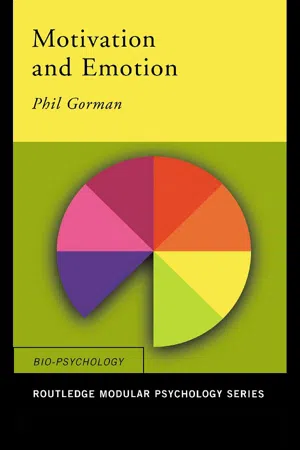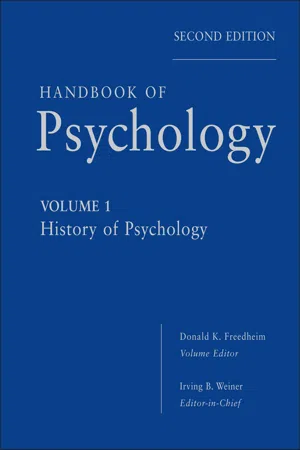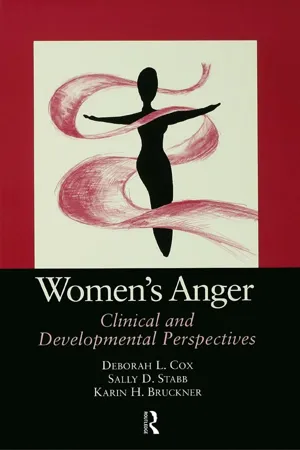Psychology
James Lange Theory
The James-Lange theory proposes that emotions are the result of physiological reactions to stimuli, suggesting that our emotional experiences are shaped by our bodily responses. According to this theory, we feel emotions such as fear or happiness after we interpret our physical reactions to a situation. This theory emphasizes the role of bodily sensations in shaping our emotional experiences.
Written by Perlego with AI-assistance
Related key terms
6 Key excerpts on "James Lange Theory"
- eBook - ePub
The Psychology of Anxiety
Second Edition
- Eugene E. Levitt(Author)
- 2015(Publication Date)
- Routledge(Publisher)
The earliest scientific attempt to explain the relationship between the subjective experience of emotion and its physiological accompaniments was advanced in 1884 by the psychologist William James, and independently a year later by the Danish physiologist Carl Lange. Briefly, the James-Lange theory proposed that the individual first senses or perceives the exciting stimulus and that this perception directly provokes autonomic reactions. The persons’s awareness of the physical changes in himself, rather than perception of the stimulus itself, leads to the subjective experience of emotion. The neural pathway must go from receptor to the cerebral cortex of the brain to the internal organs and back to the cortex. Neural impulses travel so rapidly that a person is unaware of the sequence. Everything appears to be happening simultaneously.Cannon and BardNot a great deal was known about the functioning of the brain at the time that the James-Lange theory was proposed, and it seemed reasonable enough. It endured for more than 40 years before it was finally overturned by the discovery of facts that it could not explain. In the 1920s, the physiologists Walter Cannon (1929/1963) and Philip Bard demonstrated clearly that manifest behavioral responses to emotional stimulation occur in animals that have been deprived neurosurgically of all autonomic reactivity. According to the James-Lange theory, this occurrence would be impossible.Cannon and Bard suggested that physiological reactions and emotional experience arise simultaneously, mediated by two lower brain centers called the thalamus and the hypothalamus. Recent advances in neurophysiology have shown that the Cannon-Bard theory was too simple, although it pointed in the right direction.THE MODERN ERACurrent theory, identified by the names of J. W. Papez, a neuroanatomist, and Paul D. MacLean, a neurophysiologist, began with Papez’ speculation that the seat of emotional control in the brain is an area called the limbic system. The limbic system is located on the medial underside of the brain and is composed primarily of paleocortex - eBook - ePub
- Philip Gorman(Author)
- 2004(Publication Date)
- Routledge(Publisher)
- Finally, it is worth returning to the starting point of this chapter, Darwin. The James-Lange theory is probably the closest to Darwin of all the theories of emotion and although it has already been criticised for its relationship to motivational states, Frijda (1986) has supported the notion of ‘action readiness’ as part of the emotional experience. Using self-reports of emotional states and action readiness Frijda, Kuipers and ter Schure (1989) found a strong correlation between a feeling of readiness for action and fear and anger and the opposite feeling for sorrow and despair. This could easily be related to the two branches of the ANS, the sympathetic branch is activated to respond actively, whereas the parasympathetic branch is activated for passive responses. Frijda further argues that such reports suggest an impulsive rather than controlled response in an emotional state, which is very close to the James-Lange view of an instantaneous response.
The Cannon±Bard theory
Cannon’s work was taken up and supported later by the work of Bard who studied the effects of cortical damage on the emotional reactions of cats and dogs. Cannon–Bard make three important points:In the 1930s Cannon performed a number of animal experiments to test the basis of the James-Lange theory and to consider possible alternatives. Cannon came to the view that the feeling of emotion and the peripheral arousal that accompanied it were completely independent and although they occurred simultaneously, it was not possible to suggest that the one caused the other. Many of the arguments behind Cannon’s view have already been outlined as part of the evaluation of James-Lange. - eBook - ePub
- G. Collier, Gary James Collier(Authors)
- 2014(Publication Date)
- Psychology Press(Publisher)
the emotion" (p. 13, italics in the original). A brief look at James's classic statement "we feel sorry because we cry, angry because we strike, and afraid because we tremble" (p. 13) shows that James used the concept of "bodily changes" very broadly to include expression (crying), instrumental acts (striking), and purely physiological changes (trembling). The role of cognitive mediation is more difficult to assess, however. James seemed to imply that "perception" precedes the bodily changes and that "feeling" these changes is necessary in order for them to have an effect. In this regard, James is very close to the self-perception position that we draw conclusions about our behavior from viewing our behavior in a way similar to an outside observer.Critics of James's theory have often started from the mistaken assumption that James stressed visceral changes taking place within the body. Cannon (1929), for example, argued that visceral changes were too slow and diffuse to serve as the basis for differentiating emotional states and suggested that changes taking place within the brain produced both the bodily changes and the emotional experience. More recently, Schachter and Singer (1962) have used similar arguments and have suggested that an emotional situation produces a general state of physiological arousal that requires a cognitive interpretation in order to differentiate it into a specific emotional state. Arnold (1960), on the other hand, has argued that experience must precede expression because the time necessary to transmit neural impulses from the limbic system (where emotions supposedly originate) to the cortex is much shorter than the neural transmission of impulses to the periphery or the activation of the hormonal system.Modern facial feedback theories differ from James's original version in two ways. First, they emphasize the role of facial expression, insisting that facial changes are the only ones with sufficient differentiation to account for the wide range of emotions occurring in humans. And, second, they postulate a more direct link between facial expressions and experience, not mediated by conscious process. Tomkins' early theory saw facial expressions as the primary determinants of emotions, and Izard and Gellhorn believe that facial expressions trigger neural circuits that elicit both the physiological reaction and the emotional experience.The importance of facial expressions during emotions is supported by those studies showing a direct relationship between facial expression and the felt experience. The intensity of the emotional experience has been found to be greater when facial expressions are exaggerated and decreases when they are suppressed (Kleck et. al. 1976; Lanzetta et. al. 1976; Leventhal & Mace, 1970; Zuckerman et. al. 1981) and manipulation of facial features, either directly (Laird, 1974) or through hypnosis (Pasquarelli & bull, 1951) has been found to change the nature of the experience. - eBook - ePub
The Emotions
A Philosophical Introduction
- Julien Deonna, Fabrice Teroni(Authors)
- 2012(Publication Date)
- Routledge(Publisher)
From a contemporary perspective, we may say that it involves at least five underlying classes of physiological changes: facial expressions, changes in skeletal muscles, alterations in vocal expression, those of the autonomic nervous system (adrenaline and cardiac rhythm), and those changes underlying the presence of polarity or valence. Perceiving these changes from the inside constitutes what is called awareness of our peripheral responses. It is in this way that the theory places the body at the center of its analysis, a side of emotions about which the theories discussed hitherto remained surprisingly silent. Another advantage is that it is not cognitively demanding, and thus accords with the intuition that children and animals have emotions. And finally, given that the reactions of the body are not reactions of the intellect, it can easily accommodate the existence of irrational emotions, that is to say those episodes in which our feelings diverge from our evaluative judgments (see Chapter 5, pp. 54–55). Note the following intriguing aspect of this analysis. One might think that James is putting the cart before the horse. Though it may be a bit of a caricature, is he not basically saying that we are sad because we feel our eyes well up and tears are shed, whereas common sense seems rather partisan to the reverse order of explanation: i.e. we cry because we are sad? This impression is due to the fact that we might regard the two explanations to be rival causal explanations. Yet this does not seem to be the right way to understand them. For James, the feeling of crying is constitutive of the emotion of sadness, and it is possible that the common-sense explanation ultimately refers to the same thing. The feeling of crying is a manifestation of sadness: it is not its effect, but constitutive of it. Still, if we interpret the theory as proposing a pure and simple equivalence between emotions and perceptions of bodily changes, two significant problems crop up - eBook - ePub
- (Author)
- 2012(Publication Date)
- Wiley(Publisher)
With the Schachter experiments, the pure organic tradition came to an end, at least for the time being. Once it had been shown that the influence of visceral response depended on cognitive factors, purely organic theories had played out their role. The line from James and Lange was switched to a more cognitive track. However, even if purely organic theories seemed untenable, visceral–cognitive interactions still involved visceral response. We turn now to other evidence on the role of the autonomic nervous system in the production and maintenance of the emotions.Emotions and Variations in Peripheral/Visceral Activity
A number of research areas are relevant to the James–Lange position on the importance of visceral activity. The most obvious is to produce an organism without a sympathetic nervous system, which should produce an absence of emotional behavior. Some animal preparations using immunosympathectomies (Levi-Montalcini & Angeletti, 1961) have been studied, but the results have been equivocal (Wenzel, 1972).The most fervently pursued area of research has been in the hunt for visceral patterning. Once James had intimated and Lange had insisted that for every discrete emotion there existed a discrete pattern of visceral response, the search was on for specifying these discrete visceral antecedents of emotion. Unfortunately, a century of search has proven fruitless.Before examining some of the purported positive pieces of evidence, we must be clear about the theoretical position involved. Specifically, it must be shown that some specific emotional experience is the consequence of (is caused by) a specific pattern of visceral response. For our current understanding of causal analyses, any experiment claiming to support that position must show at least that the visceral pattern occurs prior to the occurrence of the emotional experience. Mere demonstrations of correlation between emotion and visceral response are interesting but do not address the issue.The most widely cited study purporting to support the physiological specificity notion is an experiment by Ax (1953). Ax exposed subjects to either a fear-provoking or an anger-provoking situation and measured patterns of physiological response to these two experimental “stimuli.” Both situations produced elevated levels of sympathetic nervous system response with some significant differences on a number of visceral indicators. We do not need to argue that this does not show any causal effects of visceral patterns. In fact, the question is: What does it show? We do not know, in the absence of extensive internal analyses and subjects' reports, what specific “emotion” the subjects experienced. - eBook - ePub
Women's Anger
Clinical and Developmental Perspectives
- Deborah Cox, Sally Stabb, Karin Bruckner(Authors)
- 2016(Publication Date)
- Routledge(Publisher)
Emotions are short-lived, occur in complex contexts along with other psychological processes such as attention, appraisal, and social interaction, and must be measured against an ongoing stream of other autonomic nervous system (ANS) functioning. Izard (1993) believes that emotion is at least partially defined by physiological responses. In his theory of differential emotions, specific feelings each have a unique set of neural processes, which, regardless of whether or not they actually are expressed, always lead to a unique conscious experience. The subjective experience of emotion may or may not be articulated, but it is always felt. Izard states, “Thus emotion has three levels or aspects—neural, expressive, and experiential—and the term ‘emotion’ refers to all three components operating as an integral system” (p. 633). What are the differences between mood, personality, reflexes, and physiological arousal? Again, what exactly is anger? Can we say that someone, particularly, some woman, is just an angry person? If so, based upon what—her own report, her affective display, or her interactions with others? In most definitions, emotion is a very short-term phenomenon—moments, minutes, rarely longer. There is some debate about whether or not certain experiences that may be sustained over time, such as hope, for example, are “true” emotions. Usually, if an emotional experience persists over hours or days, it is then termed a mood. If moods become chronic or integrated into a person’s everyday way of being in the world over months or years, we choose to call them personality. As stated previously, some theorists see physiological arousal as a necessary prerequisite for emotion to occur. Some see physiological arousal as a concomitant response for many, but not all, kinds of emotion
Learn about this page
Index pages curate the most relevant extracts from our library of academic textbooks. They’ve been created using an in-house natural language model (NLM), each adding context and meaning to key research topics.





